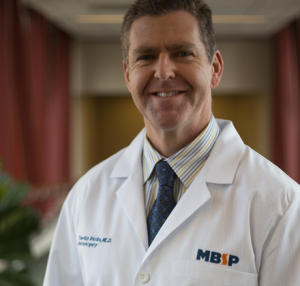
Optune: New Toxic-Free Treatment For Brain Tumors
By Dr. Tim Burke, Neurosurgeon, Maryland Brain, Spine + Pain
Cancer treatment has evolved in ways never thought possible, making the ‘C word’ a little less frightening. As a physician, I’m grateful to have more options for my patients. Those with glioblastoma (GBM) brain tumors, for instance, can try Optune therapy.
What is Optune?
Optune, a non-invasive regional therapy, targets dividing cancer cells in the brain and, generally, does not harm healthy cells. I recommend Optune to patients who are newly diagnosed, and to those who have received a repeat diagnosis of GBM and have already undergone traditional surgery and radiation treatments. Optune has been shown to be as effective as adding another chemotherapy medication, without the additional side effects or toxicity.
How Does Optune Work and What is the Treatment Regimen?
Optune uses alternating electrical fields, called Tumor Treating Fields, which travel across the upper part of the brain and disrupt a tumor cell’s ability to divide and replicate. When cancer cells grow, they divide quickly in uncontrolled ways, forming masses known as tumors. If a cancer cell cannot duplicate itself, it dies. A dead cancer cell is the only kind you want to have.
Optune therapy is delivered painlessly through 4 electrodes placed directly on the scalp with adhesive pads. Each patient undergoes an MRI to determine electrode placement and maximize the therapy’s results. The electrodes connect to a portable battery pack.
Each Optune unit is custom configured based on the patient’s anatomy and tumor location. Through consultation, the patient learns proper electrode placement and how to care for the Optune unit. A Dedicated Device Specialist (DSS) then helps patients incorporate Optune into their daily lives. Fortunately, patients can continue most daily activities –even showering – while using the unit.
Studies show that Optune therapy is most effective if used more than 18 hours a day. To help patients track usage, the Optune device records the amount of time patients use it each day.
Does Optune Therapy Hurt?
My patients who use Optune therapy do not complain of pain or major side effects. At most, they say their heads feel warm while receiving the therapy. They cannot feel the electric fields passing through the electrodes that target the tumor.
Most alternative treatments involve risky and toxic chemotherapy. But the most severe side effect of Optune is a localized rash from the adhesive pads.
Fast Facts About Optune:
- The Optune electrodes deliver low intensity, alternating electric fields within the frequency range of 100-300 kHz.
- To work effectively, the transducer arrays must be placed directly on the scalp, so patients must keep their heads shaved throughout treatment. They can wear a breathable hat, scarf, wig or other head covering over the transducer arrays.
- Patients have a dedicated Novocure Device Support Specialist (DSS) to help them – and their caregiver – start and manage treatment.
- The transducer arrays need to be replaced one to two times per week (every 4 to 7 days), depending on factors like how much patients sweat and how quickly their hair grows.

Dr. Timothy Burke, MBSP neurosurgeon
Dr. Burke specializes in Stereotactic radiosurgery (non-invasive treatment of tumors), Complex Cranial and Pituitary Gland Brain Tumors, and Neurosurgical Disorders. He is a member of Anne Arundel Medical Center’s cancer team, and certified in the use of the Optune system.
Contact an MBSP neurosurgeon today and ask about our treatment programs.



